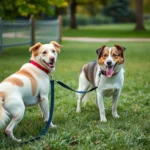
Understanding dog breed groups is crucial for any potential dog owner. These groups significantly impact a dog’s behavior, training, and care requirements. With the rising interest in pet ownership, it’s essential to make informed decisions about which breeds align with your lifestyle.
What Are Dog Breed Groups?
Definition of Dog Breed Groups
Dog breed groups classify various breeds based on shared traits, characteristics, and historical functions. This classification helps potential dog owners understand the general behaviors and needs of different breeds. The American Kennel Club (AKC) is one of the primary organizations that categorize breeds into distinct groups, allowing for easier selection for prospective pet owners.
Historical Context
Historically, dog breeds were categorized based on their roles in human society. From hunting and herding to companionship and protection, the evolution of dog breed groups reflects the diverse tasks that dogs have performed alongside humans. Over time, as the roles of dogs changed, so did the classifications, leading to the modern groupings we recognize today.
Major Dog Breed Groups
Sporting Group
The sporting group includes breeds that were originally developed for hunting and retrieving game. These dogs are characterized by their energetic nature, friendly demeanor, and excellent instincts. Common breeds in this group include the Labrador Retriever and the Golden Retriever.
Owners of sporting breeds typically lead active lifestyles, engaging in outdoor activities such as hiking, running, and swimming. Regular exercise is vital for these dogs, as they thrive on physical stimulation and mental challenges.
Hound Group
Hounds are renowned for their keen sense of smell and hunting prowess. This group includes breeds like the Beagle and the Dachshund, which possess strong tracking abilities.
Hound owners should consider their dogs’ need for ample exercise and mental stimulation. Due to their hunting instincts, hounds often enjoy activities like scent work and long walks, making them well-suited for active families or individuals with outdoor access.
Working Group
The working group consists of breeds that have been trained for specific tasks, including protection, service, and rescue. Noteworthy breeds include the Boxer and the Siberian Husky.
These dogs require a firm, consistent training approach and thrive in environments where they can engage in purposeful activities. Owners with an active lifestyle will find a great companion in a working dog, as they enjoy physical challenges and mental stimulation.
Terrier Group
Terriers are known for their energetic and feisty personalities. This group includes breeds such as the Jack Russell Terrier and the Bull Terrier.
Terrier owners should be prepared for a lively companion that requires structured playtime and mental challenges. Regular exercise is essential to channel their energy positively, making them ideal for active households.
Toy Group
The toy group includes small breeds primarily bred for companionship. Breeds like the Chihuahua and Pomeranian are perfect examples of this group, known for their affectionate nature and portability.
Toy breeds typically adapt well to apartment living and require less exercise than larger breeds. However, they still need regular socialization and playtime to remain happy and healthy.
Non-Sporting Group
The non-sporting group comprises a diverse range of breeds with varying characteristics. Examples include the Bulldog and the Dalmatian.
These dogs do not fit neatly into other categories, showcasing a wide array of traits and temperaments. Owners of non-sporting breeds should consider their dog’s unique needs regarding exercise and grooming, as requirements can vary significantly across the group.
Herding Group
Herding dogs are known for their intelligence and strong instinct to control the movement of other animals. Breeds like the German Shepherd and the Australian Shepherd exemplify this group.
Herding dogs thrive in environments where they can engage in mentally stimulating activities. They require consistent training and regular exercise to keep them happy. Owners should prepare for an active lifestyle, as these dogs excel in agility and obedience training.
Mixed Breed Groups
Mixed breeds are often overlooked but provide unique advantages. These dogs combine traits from different breeds, resulting in unpredictable yet often desirable qualities.
Adopting a mixed breed dog can offer a loving companion while promoting responsible pet ownership. Mixed breeds are often available in shelters, providing an opportunity to give a dog a second chance at life.
Choosing the Right Dog Breed Group for Your Lifestyle
Assessing Your Lifestyle
When considering a dog, it’s essential to assess your lifestyle. Factors such as your activity level, living space, and family dynamics play a vital role in selecting the right breed group. For example, active individuals or families may thrive with sporting or working breeds, while those with a quieter lifestyle might prefer a toy or non-sporting breed.
Matching Breeds to Lifestyle
Aligning specific dog breed groups with your daily routine is crucial for a successful pet-owner relationship. High-energy breeds require ample exercise and stimulation, while more laid-back breeds may fit well into a less active lifestyle. Understanding your schedule and commitments will help you choose a breed that complements your lifestyle.
Considerations for First-Time Dog Owners
First-time dog owners should focus on breed groups that are known for their temperament and training ease. For instance, sporting and toy breeds often have friendly dispositions and are easier to train. Researching the specific needs of various breed groups can help new owners find a companion that fits their skills and experience level.
Training and Care by Breed Group
General Training Tips for Different Groups
Training approaches should be tailored to the specific needs of each breed group. For instance, sporting dogs often respond well to positive reinforcement techniques, while terriers may require more structured training due to their high energy levels.
Establishing clear communication and consistency in training will foster a strong bond between the owner and the dog, enhancing the overall training experience.
Health Considerations
Each dog breed group has its own set of common health issues. For example, some sporting breeds may be prone to hip dysplasia, while certain toy breeds may face dental problems. Understanding these potential health concerns can guide owners in preventive care and regular veterinary visits.
Grooming Needs
Grooming requirements vary significantly across breed groups. While sporting dogs may require regular bathing and brushing, non-sporting breeds may have more specific grooming needs based on coat type. Owners should familiarize themselves with their dog’s grooming requirements to maintain their health and appearance.
The Role of Dog Breed Groups in Responsible Pet Ownership
Understanding Breed-Specific Legislation
In some areas, breed-specific legislation affects certain breeds, often due to misconceptions about their temperament. Understanding these laws is crucial for potential dog owners, as non-compliance can lead to serious consequences.
Responsible pet ownership involves being aware of local regulations and selecting a breed group that aligns with your community’s laws.
Promoting Adoption and Mixed Breeds
Promoting the adoption of mixed breeds from shelters is a key aspect of responsible pet ownership. Mixed breeds often possess the best traits from various breeds, leading to well-rounded companions.
Additionally, adopting dogs from shelters helps combat overpopulation and gives a loving home to a dog in need. Recognizing the value of mixed breeds can enrich the lives of both dogs and their owners.
Conclusion
Understanding dog breed groups is essential for making informed decisions about pet ownership. By considering your lifestyle and the specific needs of different breeds, you can choose a dog that will thrive in your home. Responsible pet ownership not only enhances your life but also ensures that your dog receives the love and care it deserves.
Taking the time to research and understand these breed groups will lead to a fulfilling relationship with your canine companion, bringing joy and companionship into your life. Embrace the journey of dog ownership, and cherish the unique bond you will create.









